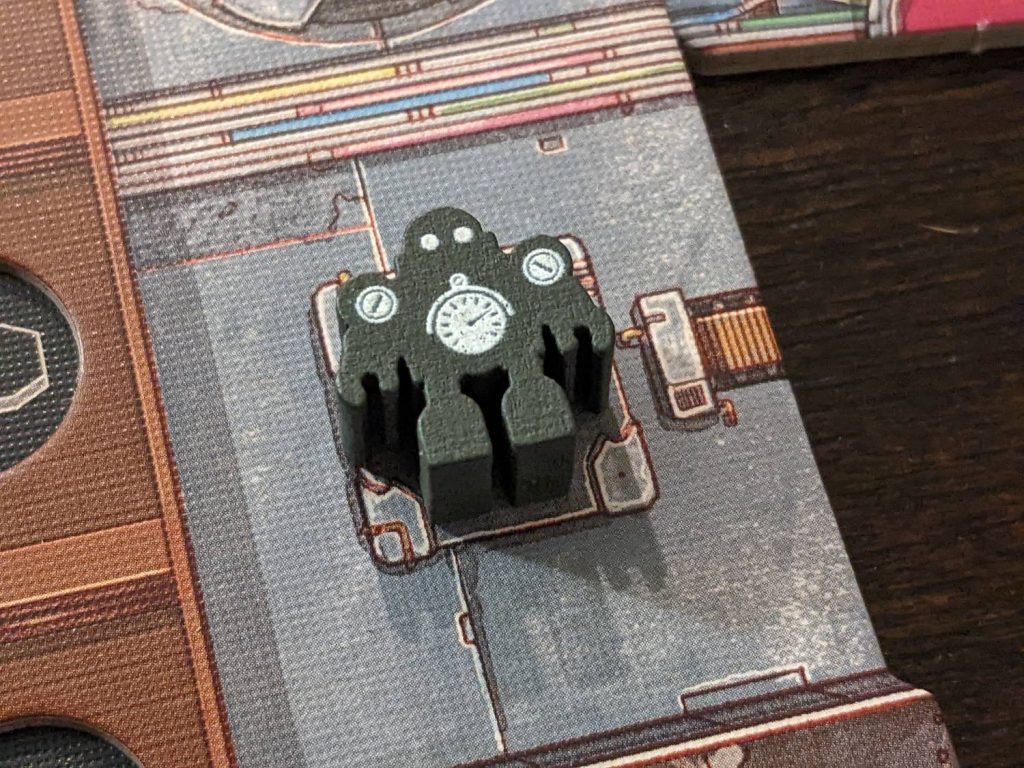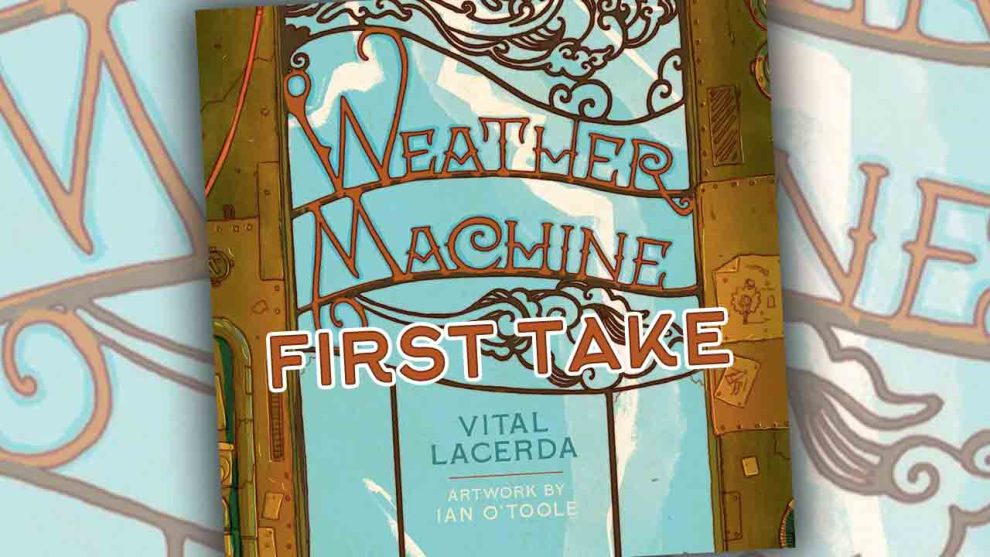“I think I’m backing Weather Machine,” said my friend Joel.
“Thank you for your service,” was the reply from the group thread, as another round of our collective game of chicken to see who would bite the $150 bullet had ended.
Many of the folks in this gaming group are fans of Lacerda games. If you are a regular follower of my content, you’ve seen my reviews of On Mars, Vinhos: Deluxe Edition, Kanban EV, and The Gallerist; I own all of those plus Lisboa, so it’s fair to say that I’m a fan of Lacerda’s work.
Joel’s copy of Weather Machine has arrived, so he invited me and two other friends to drop by and play. To prepare, I watched the massive 44-minute teach video by frequent Lacerda collaborator Paul Grogan not just once, but three times because the rules overhead was so high. All four players committed to knowing the rules as well as we could before trying to sit down and play.
After a single play, I’m left with…feelings.

This is Weather Machine
Players take on the roles of scientists working for the world’s worst boss: a mad scientist by the name of Professor Sêni Lativ, Project Chief of Meteorological Manipulation at Lightning Technologies. (It’s a mouthful, alright.) Lativ and his team have a problem: Lativ’s recent invention, known as the Weather Machine, is making weather issues a thing of the past in certain parts of the world, while making weather dangerous to humankind in other regions.
Over a number of rounds, you’ll move your single pawn to one of four locations and take actions. You can upgrade your player board by visiting the Supply area, constructing bots from your player mat to make available on later turns, or increasing storage capacity. You can visit the Government area to help work out weather issues by supplying them with bots that support research projects, which also provide government Subsidy tiles that grant a one-time bonus action prior to the start of a turn.
The other two action locations are more complex. Lativ’s Lab is where a player can pay chemical resources to place a previously-constructed bot in one of the five areas of research that will trigger at the end of all turns in a round. From a market display of three face-up project tiles, projects will run if there are enough bots in the column where Lativ’s assistant is currently working. This is a way to earn points and bonuses, but also to write research papers if a player has gathered enough of the same type of research tied to a topic (rain, snow, etc.).
Research & Development (R&D) is the final area of the board where players can take actions—R&D is also the hardest section of the board to get right because of all the things required to pull off a successful turn. You can bury one of your bot workers here by paying a cost and getting a reward, but like the Government area, you’ll never see that bot again. On later turns, you could try to build a prototype with a mix of Machine Parts that have been collected earlier in the game, which could score a river of Climate Points, this game’s version of victory points.
All the while, Lativ is represented by a pawn that is strolling around the board. My first thought while learning Weather Machine was that Lativ would play the part Sandra played in Kanban EV. I was wrong about that, and not in a good way.

Let’s Start with Lativ
There are a total of 13 available worker spaces in Weather Machine: four in Supply, then three each in Government, R&D, and Lativ’s Lab. Supply has five different actions available, with the other locations having two actions each. There is a 14th space, Lativ’s Office, which can only be filled by Lativ’s pawn; this triggers an income round if he ends any round in his office. Whenever a human player visits a location where Lativ currently is, he moves to the next space in a rotation until he ends in his office.
When I first watched the teach video, I thought Lativ would be a central figure in the action, because I was so used to the timing considerations of how scoring works in Kanban EV. The reality is that Lativ is somewhat inconsequential here.
Lativ provides a small bonus if you visit his location AND you place your pawn to the right of his pawn in one of the available spaces. Doing this will give you a science “voucher” (the game’s currency, and science vouchers are wild) and science vouchers are important when experiments run in Lativ’s Lab at the end of each round. So, it’s not nothing, but it also ain’t that much.
Otherwise, Lativ is just kind of in the way.
In our first play, the number of times a player intentionally went to Lativ’s section of the board just to get a single science voucher was tiny. And Lativ will naturally end up in his office every other round, maybe every third round, simply because players must move to a different location each turn.
On one turn, a player was hoping to use the “and” space of the Government location—one of the three spaces in each of the R&D, Government, and Lativ’s Lab sections allows for a player to do both of that location’s actions. When Lativ moves, he blocks the left-most space, which is always the “and” space if available. So, for one turn, tough luck, but this player was still able to do what he wanted to do on a later turn without consequence.
That won’t always be the case, but it brings to mind a question: what role does Lativ really serve in the design? In our first play, we didn’t see it, at least not in the way 30 or 40 plays might. Maybe it’s a strategy to play off of Lativ and expert players always go where Lativ is to keep science voucher numbers up, but that would be surprising.
I think the “Lativ Problem” is my general issue with the game; Lativ, like Weather Machine, is the first in a series of minor disappointments.

Tracks
Weather Machine, like most of the Euros I’ve played this year, has tracks. The tracks aren’t special, but they are brought down a touch by having rules that feel as if they were inserted for rules’ sake.
There is a track above each of the game’s three major locations: Government, R&D, and Lativ’s Lab. Like tracks in other games, these tracks are useful for end-game scoring and resource collection, by using the game’s Investment feature to turn a previously-played goal tile over to collect resources (“Funding”) when you need them most.
One track gives you Funding based on everything below and to the left of your Funding marker. A different track gives you the choice of a single reward from the selection of items below and to the left of your marker. The third track goes bananas: you get everything below and to the left of your Funding marker on this track, then you also get the bonuses of one of the two other tracks, in addition to a multiplier based on where your marker is on the first track to augment the bonus you take on one of the two other tracks.
WHAT?
I still have no idea why this process is so complicated. People that accuse some of these heavier games of having rules purely for the sake of rules are right on track here. (You see what I did there!)
Now, my bigger thing with the tracks in Weather Machine is that the game’s bullet list of features feels like a standard Euro in 2022: personal goal tiles, executive/bonus actions, worker placement, arbitrary rules around resource collection and storage, screen-printed meeples, dual-layered player boards, artwork by a struggling, little-known artist named Ian O’Toole. (I kid. It’s weird when I play a big-name title that doesn’t have artwork by Ian O’Toole!)
Weather Machine feels somewhat ordinary for a game of the now. Those hoping for innovation should look elsewhere. This lack of unique elements might have been the most surprising part of my first play. I was hoping for a few magic moments, and certainly there are some interesting turns as you work out your plans.
However—and this is certainly true if you have played Kanban EV—I’m not sure I saw anything in that first play of Weather Machine that gave me those great vibes like the ones in Kanban EV when I first worked out the main sequence loop. Designing a car, pushing that car out onto the test track, adding that car to my garage, and looking forward to the end-of-week meeting with Sandra while licking my chops over the meeting cards I had in my hand to play that round, all while staying one step ahead of Sandra before she looked into my department.

The Market
Which gamers are the market for Weather Machine?
Despite all of my issues, these issues are generally minor in the grand scheme of things. Weather Machine is an above-average game with the normal stellar production elements you would expect for a luxury gaming good from Eagle-Gryphon Games. While the combos are not as rich as in games such as Tiletum, there are going to be a few fun turns every time you play Weather Machine.
The rules overhead is high here, even for a Lacerda veteran. I know this because I’ve spoken to a few others who have butchered their first plays of Weather Machine thanks to this overhead. There are certain things that break the game’s rules, particularly Subsidy tiles that let you take an entire turn of actions before taking your main turn, and getting the rules right in the game’s Phase B (Run Weather Machine Experiments) is vital to scoring and the game’s timer.
I think this means that Weather Machine is going to disappoint other long-time Lacerda fans. I would never choose Weather Machine if I wanted a rules-heavy experience with the same level of production over On Mars, Kanban EV, Lisboa, or The Gallerist. As someone who likes Escape Plan but can never get Lacerda veterans to play it, I would still recommend Escape Plan as the better, quicker introduction to Lacerda games.
I think Weather Machine is best suited as a medium-heavy Eurogame for someone who is always calling you and asking when the next Lacerda gaming event is happening at your house because they want tried-and-true experiences in heavy games. Show them Weather Machine, see what they think, and if they want more, give them Vinhos: Deluxe Edition and see if they fall in love or not.

News and Notes
Thematically, Weather Machine is the Lacerda experience that feels the least immersive.
The Gallerist is my #1 Lacerda in terms of theme, with Vinhos: Deluxe Edition not far behind. Kanban EV is so thematic that it is frightening, with the idea that my boss is constantly grading me to make sure I was the right person for the job.
I’ll admit that Lisboa feels like it’s just a game—a very good game, but you’re always looking at it like it’s a game. I’m never really caught up in rubble from a city destroyed by disaster as much as “I need blue cubes to complete X” or “if I play this card, then Y.” Even in Escape Plan, the game’s systems play into the game’s theme, and it feels like I need to move around town to grab the loot I stashed at the gym.
Weather Machine is supposed to be about fixing the weather. But it doesn’t have the same kind of tension tied to its theme and I never felt anything more than “I need a magenta cylinder because the tiles in my workshop connect to create a magenta circle so I need to find spaces where I can spend the magenta thing.” Those hoping to be absorbed by a game world will find disappointment in Weather Machine.
I love the player boards. I love the main board, although it’s certainly loaded to the hilt with iconography. It’s not as clean as Vinhos, but I like O’Toole’s layout and finding what you need here is easy.
The player aid has almost everything you need, but the layout is a miss. The actions summary should never be in the middle of a player aid. A breakdown of Subsidy icons is here, but it’s on the back cover, where the action summary should be. Why is the front cover of the player aid blank? It’s a bit wasteful, as if you are holding a food menu expecting to see appetizers on the front page but instead see the history of the restaurant. At this point, I don’t care about the game’s backstory; I have questions about the 87 icons I need to decipher!
The elephant in the room here is downtime, compounded by the initiative action option in this game. Like other Lacerda games, you can change the turn order almost every round. This, combined with some long turns, could lead to a situation where you will wait 25 minutes between turns if you were the first player, two other players moved up ahead of you during the current round, then the next round begins and you go third in the following round. (Yes, this 25-minute gap happened to another player during our game. I had a gap of just under 20 minutes waiting for one turn of my own.)
Although 25 minutes was the longest a player had to wait between turns, you will regularly have to wait 10-15 minutes between turns if you are doing a four-player game. That’s just the reality of how the game was designed. Overall playtime for a first game will probably land in the three-hour range at the full player count.
I can already hear some players now: “That won’t happen to my group Justin, because all of our group members play fast. They never take heavy AP turns!”
Incorrect. As the person others know as the fastest person they have ever seen play games (not best, mind you: fastest), and who played every rule correctly in my first play of Weather Machine, I can assure you that some of your turns will be long. That’s because some of the turns, played correctly, have five steps, and that’s before you take a bonus action on that same turn.
This is the fault of the game, not the players. The design is built to require players to react in a more tactical fashion to the changing state of the board. One player suggested, and I concur, that you are in some ways best off looking away from the board until it is your turn because so much can change between turns. On our third Phase B of the game, three different players researched a wind experiment, which exhausted all three of the wind research tiles from the game.
Were you hoping to build a set of wind research tiles as a part of your long-term strategy? Bad news, that goal is officially off the table.
That area control portion of the first column of the Government Machine area? Between your last turn and now, one player took that action on the board, while another player did the same thing but preceded their turn with a Subsidy tile that let them take a free action, closing out that column. Things change quickly in Weather Machine. I like this, but it also leads me to believe that reacting to the current game state is better than planning too far ahead.
Weather Machine isn’t bad, but it is firmly on a tier below the all-time Lacerda classics referenced in this article. It would shock me if any invested Lacerda fan eventually made this their favorite of his designs, and it wouldn’t shock me if this game is widely available on the secondary market by this time next year.












As a playtester who has several games under my belt I feel inclined to say that Lativ’s impact will show as you get more games in and play against more competitive players. The science voucher is nice to have but the main reason why you’d want to bump him is to block off the double action spot when you see someone about to have a big turn. You might say that they’ll just do the same 2 actions in two separate turns then but there’s only around 12 rounds in the game so that’s a huge hit to efficiency. Also the fact that as with many of Vital’s other games you can’t go to the same place for 2 consecutive rounds means that you’ll have to come back the turn after. We know how important timing is in Vital’s games and it is especially so in this game given the nature of the experiments.
Blocking off double lab when someone is about to publish forces someone to choose between publishing and participating in an experiment and missing out on either one can disrupt your tempo for a while. Often a times players use double R&D to place a bot and get a discount on parts for the prototype, if I see someone about to do that and Lativ is in position I’d strongly consider pushing Lativ to block off double R&D. Double government is just really strong especially at the beginning such that people will go back to supply round 2 just to push Lativ to block it off. Weather Machine is one of the few games I’ve played where you don’t have to go to an action space yourself to block it off, and since everything you can do is open information, confrontational players will absolutely try and give you a hard time.
As for downtime, I’ve found that 4P games with experienced players tend to last around 2hrs, although that’s between players with at least 10 games under their belts.
For me it’s uniqueness within Vital’s games comes from the multiple workflow management that’s required to score well. Whereas in Kanban or The Gallerist you follow a fairly linear get design & parts -> get cars & upgrade designs or buy art -> sell art workflow, here you’re following the research -> publish -> prototype workflow but to do well you’ll need to multi-task and simultaneously work on multiple sets of weather tokens, channeling the bonuses you get from completing a stage in one workflow into another workflow and pulling that off in spite of disruptions from other players is extremely satisfying.
I agree that it’s theme is more abstracted than his other games but as with all games I personally play them for their mechanics. And it didn’t give me a very good first impression either. The game really needed multiple plays for me to appreciate it, but at this point I really like it! It’s below On Mars, Lisboa, and Kanban for me (well those 3 are hard to top in general) but I personally like it more than The Gallerist and Vinhos.
Thanks for the feedback! Looking forward to trying this again.
The depth and specificity of what you wrote was engaging and well done. It
was pleasure reading that.
Thanks! Have you tried the game? Always excited to hear more opinions from other players.
Oh one thing I forgot to mention. Lativ places a bot on the active branch when he gets bumped (or the next branch that doesn’t have one of his bots if there’s already one of his bots on the active branch). So if you need an experiment to run but aren’t confident that other players will jump on board, you can bump Lativ to place one of his bots onto that branch. Quite often this involves me placing 2 bots and bumping Lativ to put one of his bots on (although at this point another player will usually want to jump on the train and kick off Lativ’s bot with one of their own). It’s quite lucrative too if you can manage it since rain / sun / snow experiments net you 6-7pts per bot.
This might actually be my most important reason for bumping Lativ and I can’t believe I forgot to mention it given how often I do it to get a 12pt experiment running lol.